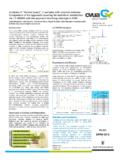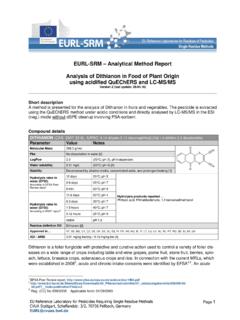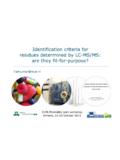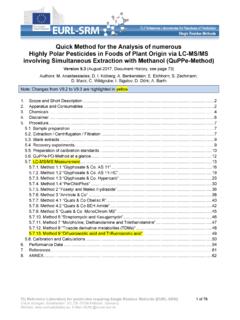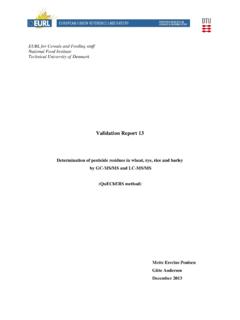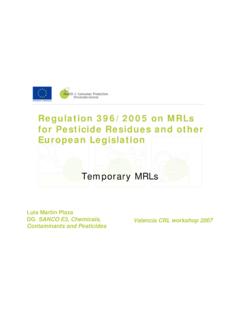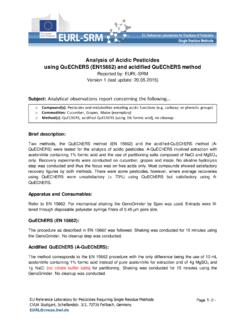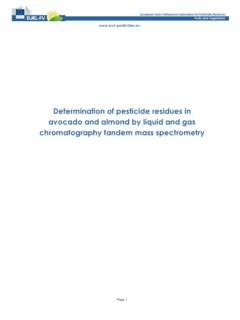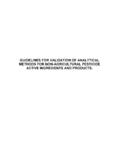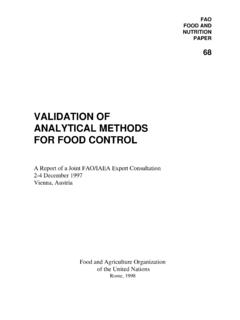Transcription of Validation Report 12 - Residues of Pesticides
1 EURL for Cereals and Feeding stuff National Food Institute Technical University of Denmark Validation Report 12 Determination of pesticide Residues in hay by LC-MS/MS and GC-MS/MS (QuEChERS method) Mette Erecius Poulsen December 2012 Page 2 o f 19 DTU, National Food Institute CONTENT: 1. Introduction .. 3 2. Principle of analysis .. 3 3. Validation design .. 4 4. Chromatograms and calibration 4 5. Validation parameters .. 7 6. Criteria for the acceptance of Validation results .. 7 7. Results and discussion .. 7 8. 8 9. References .. 8 Appendix 1. MRM transitions for the validated Pesticides analysed by LC/MS/MS.. 9 Appendix 2. MRM transitions for the validated Pesticides analysed by GC/MS/MS .. 11 Appendix 3.
2 Recoveries, repeatability (RSDr) and Limit of Quantification (LOQs) for Pesticides validated on Hay.. 14 Appendix 4: Principles of the QuEChERS method for cereal extraction .. 19 Page 3 o f 19 DTU, National Food Institute 1. Introduction This Report describes the Validation of the QuEChERS method combined with LC-MS/MS and GC-MS/MS. The method was validated for 75 Pesticides and degradation products in hay matrix. The QuEChERS method has an extraction and clean-up step, which has been developed to be Quick, Easy, Cheap, Efficient, Rugged and Safe. The method is most commonly used on fruit, vegetables and cereals1. The method were slightly modified due to the dry texture of the hay. 2. Principle of analysis Sample preparation: The hay samples was is grinded on a cutting Mill SM 2000 fro m Retsch equipped with a sieve at 1 mm (see foto below).
3 Extraction: One gram of sample was added 10 ml of water and left for 30 min. Then the samples were added ml acetonitril and the samples was shaken. S alt and buffer mixture was added and the sample was shaken again. Clean-up: After centrifugation the supernatant was transferred to a tube with PSA and MgSO4. After shaking and an additional centrifugation step the final extract is diluted 1:1 with acetonitrile to obtain the same matrix concentration as in the calibration standards. For the LC-MS/MS analysis the extraction is followed by adding internal standard and the extract is filtered into HPLC vials. Quantification and qualification: LC-MS/MS: The pesticide Residues are separated on a reversed-phase column and detected by tandem mass spectrometry (MS/MS) by electrospray (ESI).
4 The Validation includes Pesticides determined with both positive and negative ESI. 13C6-carbaryl was used as internal standard for quantification. All Pesticides were detected in the multiple reaction monitoring mode (MRM). For each pesticide precursor ion and 2 product ions were determined. One product ion for quantification and one for qualification. The MRM transitions for the Pesticides and degradation products sought validated are given in Appendix 1. GC/MS/MS: The pesticide Residues are separated on a DB5-MS column and detected by tandem mass spectrometry (MS/MS) operating with electron energy at 70 eV, source temperature at 180 C and transfer line at 250 C. The injection volume was 4 l. All Pesticides were detected in the multiple reaction monitoring mode (MRM).
5 For each pesticide two transistion were determined. One for quantification and one for qualification. The MRM transitions for the Pesticides and degradation products are given in Appendix 1. Page 4 o f 19 DTU, National Food Institute 3. Validation design The method was south validated for 93 Pesticides or degradation products in hay . The Validation was performed on 5-6 replicates on each cereals commodity at each of the three spiking levels; , and mg/kg. A blank sample of hay was included. 4. Chromatograms and calibration curves The calibration curve is determined by the analysis of each of the analysts at at least 4 calibration levels, , , and g/ml. The calibration curves were best fitted to linear curves.
6 The quantification was performed from the mean of two bracketing calibration curves. The majority of the correlation coefficients (R) were higher or equal to 9. Examples of chromatograms obtained when analysing the extracts by LC-MS/MS and GC-MS/MS are presented in Figure 1. Examples of calibration curves are presented in Figure 2. Page 5 o f 19 DTU, National Food Institute :MRM of 9 channels,ES+239> Smooth(SG,1x2) 17. Spk. 0,020 ppm Halm +004 Pirim :MRM of 9 channels,ES+239 > Smooth(SG,1x2) 17. Spk. 0,020 ppm Halm +004 Pirim :MRM of 8 channels,EI+388>345130306st21 Smooth(Mn,2x2) Valid. halm spk. m. samstik A ppm C 1:1 +003 Azo xys tro b i :MRM of 8 channels,EI+344>329130306st21 Smooth(Mn,2x2) Valid.
7 Halm spk. m. samstik A ppm C 1:1 +003 Azo xys tro b i Figure 1: Examples of chromatograms for pirimicarb mg/kg on LC-MS/MS and azoxystrobin mg/kg on GC-MS/MS (two MRM transitions are shown for each pesticide). Page 6 o f 19 DTU, National Food Institute Compound name: PirimicarbCorrelation coefficient: r = , r^2 = curve: * x + type: Internal Std ( Ref 1 ), Height * ( IS Conc. / IS Height )Curve type: Linear, Origin: Include, Weighting: 1/x, Axis trans: Compound name: AzoxystrobinCorrelation coefficient: r = , r^2 = curve: 102134 * x + type: External Std, AreaCurve type: Linear, Origin: Exclude, Weighting: 1/x, Axis trans: Figure 2. Examples of calibration curves for pirimicarb (LC -MS/MS, concentrations from g/ml) and azoxystrobin ( GC-MS/MS, concentrations from g/ml).
8 Page 7 o f 19 DTU, National Food Institute 5. Validation parameters Precision repeatability Repeatability was calculated for all Pesticides and degradation products on all three spiking levels. Repeatability is given as the relative standard deviation on the result from two or more analysis at the same sample, done by the same technician, on the same instrument and within a short period of time. Repeatability in this Validation was calculated from the 5-6 replicate determinations. Repeatability were calculated as given in ISO 5725-22. Appendix 3 shows the relative repeatability for the validated Pesticides and degradation products. Accuracy Recovery The accuracy was determined by recovery, samples were spiked at three concentration levels.
9 In appendix 2 and 3 recovery, repeatability and limit of quantification (LOQ) are given for the validated Pesticides , isomers and degradation products for all three spiking levels ( mg/kg, mg/kg and mg/kg). Recoveries is listed in A ppendix 3. Robustness The QuEChERS method has earlier by Anastassiades et al. 20031 in connection with the development of the method been shown to be robust. Limit of quantification, LOQ Quantification limits (LOQ) are calculated from the results at the lowest accepted spike level, as 6 times the standard deviation (absolute recovery). The quantification limits are given in Appendix 3. 6. Criteria for the acceptance of Validation results For the Pesticides to be accepted as validated the following criteria for precision and trueness must to be fulfilled: 1.
10 The relative standard deviation of the repeatability must be less than or equal to the standard deviation proposed by Horwitz3. 2. The average relative recovery must be between 70 and 120%4. If the above mentioned criteria have been meet, the detection limits have been calculated. 7. Results and discussion The method was sought validated for 94 compound. Two different detection system was used, LC/MS/MS and GC/MS/MS. In general, the compounds analysed on LC/MS/MS could be detected Page 8 o f 19 DTU, National Food Institute at all three spike levels, while it was the case for only one fifth of the compounds measured on GC /MS/MS. T en compounds were measured on both LC/MS/MS and GC/MS/MS and for these compound the results from LC/MS/MS was better and more pesticide were validated.
